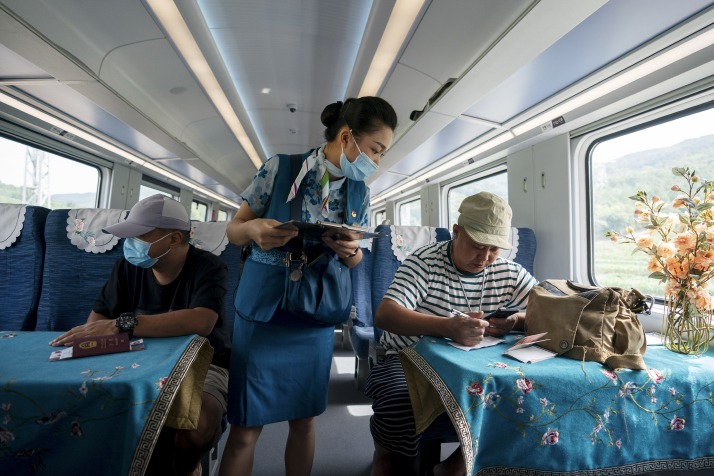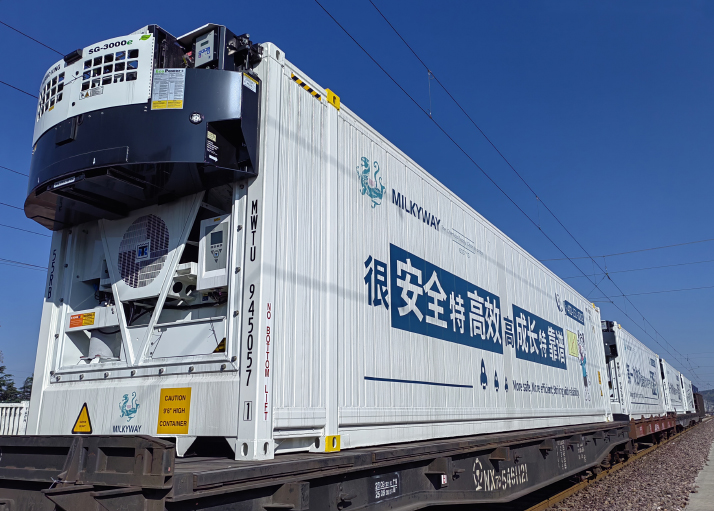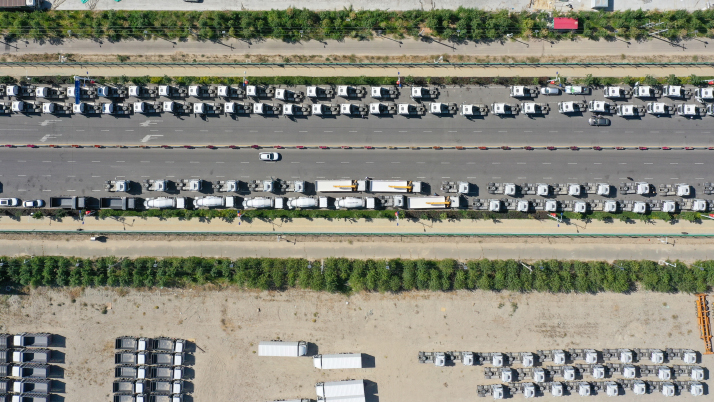| Business |
| Chinese enterprises engage in Belt and Road cooperation | |
|
|
 A train attendant helps an outbound passenger complete his exit forms on a Laos-bound train running on the China-Laos Railway on July 16 (XINHUA)
After having graduated from the Yunnan University of Finance and Economics in the southwestern province of Yunnan in 2022, Chansouk Souanmixay, a Laotian in his 20s, took the opportunity to reconnect with China last year, when he applied for an internship as a translator at the Laotian branch of China Railway No.2 Engineering Group (CREC-2). Owing to his experience in China and fluent standard Chinese he was admitted to the internship program. Upon completing that, he started working for the company fulltime.
CREC-2, along with many other engineering groups under the state-owned China Railway Group Ltd., was a major participant in the construction of the 1,035-km China-Laos Railway. The flagship project of the Belt and Road Initiative (BRI), which began operating in December 2021, has helped turn Laos from a land-locked country into a land-linked hub in Southeast Asia. The BRI, proposed by China in 2013, aims to boost connectivity along and beyond the ancient Silk Road routes. By June this year, 152 countries and 32 international organizations had signed documents for Belt and Road cooperation with China. As of August 3, the China-Laos Railway had transported 19 million passengers and 23 million tons of goods, according to China State Railway Group. "Traveling in Laos used to be difficult, as there was no railway before. Now we can travel conveniently on the China-Laos Railway," Souanmixay told Beijing Review. The railway reduces the time it takes to travel from Vientiane, capital of Laos, to Luang Prabang, a famous ancient city in the north of the country, from eight hours to less than two hours. The Chinese Ministry of Foreign Affairs said in May that the China-Laos Railway had recruited around 3,500 Laotian employees, and created over 100,000 jobs in logistics, tourism and trade industries along the line. Many Chinese enterprises have engaged in investment, trade and business cooperation along the Belt and Road routes over the past decade. Chinese state-owned enterprises (SOEs) and private firms are important allies in the expansion of the BRI concept, Peter Koenig, a non-resident senior fellow with the Chongyang Institute for Financial Studies at the Renmin University of China (RDCY), told Beijing Review. "In addition to being associates to firms in other BRI participating countries, they are also expanding commercial relations between China and those countries, thereby significantly contributing to the economic growth of both sides," Koenig said. Growing participants Over the past decade, China has signed new contracts for engineering projects worth approximately $1.2 trillion with other BRI participating countries. Its trade with these countries expanded from around $1 trillion in 2013 to over $2 trillion last year, according to the Ministry of Commerce (MOFCOM). A growing number of Chinese SOEs are participating in large transportation, energy and telecommunication projects in other BRI participating countries. The China-Laos Railway is a result of the joint efforts of many Chinese SOEs, including the construction of the railway itself, the manufacturing of trains and electricity supply along the line. The 9.59-km Friendship Tunnel of the railway is on the border of the two countries. Yang Longwei, head of the technology section of the Second Engineering Co. of CREC-2, told Beijing Review that work on the tunnel lasted from 2016 to 2021. The construction team had to overcome challenges created by the area's complicated geology as the rock contained as much as 80 percent salt, making it exceptionally susceptible to erosion by water. It was a situation the team had never before encountered. Around 1.7 km of the tunnel was bored through this salt-containing rock. Through over a year of research and development, the team developed new concrete materials to prevent erosion. Work on that section of the tunnel took nearly three years. "We have also treated discarded rock salts to guard the soil from becoming saline to protect local environment," Yang said. Chinese private enterprises have also been active in Belt and Road cooperation. Based on over 20,000 projects launched in 2005-22, a report released by Nankai University in July showed more than half of China's investment in other BRI participating countries during the period were made by private enterprises. According to the General Administration of Customs of China, private enterprises accounted for 58.6 percent of China's trade with Belt and Road partners in the first three months of this year. "The participation of private companies, which are given the same access to the initiative as SOEs, demonstrates the deepening of China's opening up," Liu Ying, a researcher with the RDCY, told Beijing Review.  A train carrying refrigerated containers of fruit from Thailand arrives at a railway station in Kunming, Yunnan Province, on April 19 (XINHUA)
Building network The China-Laos Railway forms one of the main routes of the New International Land-Sea Trade Corridor. Launched in 2017, the corridor is a trade and logistics passage connecting western Chinese regions and countries of the Association of Southeast Asian Nations (ASEAN). On June 8, the first China-Laos-Thailand cold-chain freight train of the New International Land-Sea Trade Corridor began its journey in Laos. Loaded with around 150,000 durians from Thailand, imported by Hongjiu Fruit Co. Ltd. in Chongqing Municipality, it reached Chongqing after four days. Before the launch of the corridor, fruit from Thailand was shipped first to eastern cities of China and then forwarded on to western destinations. "The new corridor has cut the time and cost of transporting fruit from Southeast Asia by over 50 percent," Deng Haoji, chief operating officer of Hongjiu Fruit, told Beijing Review. "Through facilitating the flow of goods, funds, technologies and personnel, the BRI has improved China's connectivity with the global market and boosted the opening up and development of domestic regions," Qi Xin, Director of the Belt and Road Economic and Trade Cooperation Institute at the Chinese Academy of International Trade and Economic Cooperation, told Beijing Review. The improving connectivity has bolstered cross-border e-commerce between BRI participating countries. As of July this year, China had signed memorandums of understanding for e-commerce cooperation under the BRI with 29 countries. Chinese e-commerce platforms are bringing international products to China while also providing services overseas. The Chinese e-commerce giant Alibaba, for example, launched the Electronic World Trade Platform (eWTP) in Malaysia in 2019, making it the first foreign country with an eHub of the company. According to Alibaba, the eWTP has provided digital support for local small businesses and offered training on digital economy for Malaysian entrepreneurs.  A foreign host live-streams in an e-commerce company in Xi'an International Trade & Logistics Park on March 3 (XINHUA)
Going global The BRI is helping increasing numbers of Chinese enterprises to establish a presence in the global market. Over the past decade, COSCO Shipping Corp. Ltd., an SOE, has invested over 600 million euros ($659 million) in the Piraeus Port in Greece. COSCO started operating two of the port's container terminals in 2010, when the European country was trapped in a severe debt crisis. In 2016, COSCO acquired a majority stake in the port and formally took over its management and operation. The global ranking of the port jumped from 93rd place in 2010 to 29th in 2021. Wan Min, Chairman of COSCO, said in July that the company had invested in the building of 57 ports in other BRI participating countries. Large Chinese tech firms like Huawei and ZTE have been exporting products and technologies to other BRI participating countries. In February this year, Huawei Türkiye signed a contract with local companies on developing energy storage systems. As more attention is being paid to green Belt and Road cooperation, low-carbon industries already booming in China are now expanding overseas. Xinjiang Goldwind Sci & Tech Co. Ltd., a leading wind turbine producer based in Xinjiang Uygur Autonomous Region in northwest China, has provided wind turbines for three energy programs in Central Asia. "Xinjiang's green technologies can be applied in countries in Central Asia, which have similar natural conditions. Their close proximity also allows efficient and low-cost transportation," Sun Lianhua, a senior executive at Goldwind Technology, told Beijing Review. The company has also built 109 wind turbines in Argentina. The turbines provide 1.6 billion kilowatt-hours of clean energy each year, replacing the use of 800,000 tons of standard coal equivalent and cutting carbon emissions by 2 million tons. The company's wind power projects in Argentina have provided 1,500 jobs for local people, Sun said. China's exports of electric vehicles (EVs), lithium-ion batteries and solar cells have been highlights of its foreign trade in recent years. Chongqing-based EV brand Seres has been supplying overseas markets since 2005. Today, its cars have been sold to many BRI participating countries including Indonesia and Egypt. The company exported 55,000 vehicles in 2022, up 37 percent year on year. "Logistics services are smooth in North African countries and their tariffs on EVs are low. We have established a sales and service center there, which covers the European and African markets," Zhang Xingyan, head of the company's international business division, told Beijing Review. Seres has also invested $150 million in the construction of a modern manufacturing facility in Indonesia, which began the delivery of vehicles in 2018. The factory allows the company to cover the ASEAN market and surrounding regions.  China-made cars ready for export to countries along the Belt and Road routes in a bonded area of Khorgas, Xinjiang Uygur Autonomous Region, on July 26 (XINHUA)
A larger picture New markets are calling, but Chinese enterprises still face challenges in going global. "Our financing options are limited and we still lack experience in localized operations," Zhang said. "The government needs to improve policies and regulations regarding BRI participation by enterprises, and urge financial institutions to meet the demands of enterprises. Enterprises should also improve their capacity to cope with potential risks," Qi said. She believes China and other BRI participating countries will cooperate more closely on the digital economy and low-carbon industries and calls for accelerating negotiations for more free trade agreements. "Expanding business and trading opportunities is already in the spirit of the BRI. Chinese enterprises could make the first move, seeking mutually beneficial opportunities for connecting a potential BRI participating country with China," Koenig said. (Print Edition Title: Cross-Border Connectivity) Copyedited by G.P. Wilson Comments to lixiaoyang@cicgamericas.com |
|
||||||||||||||||||||||||||||||
|
